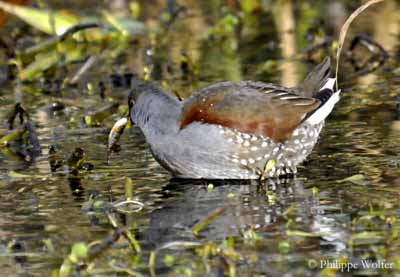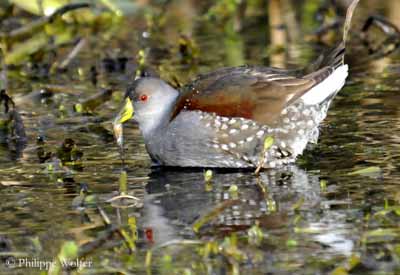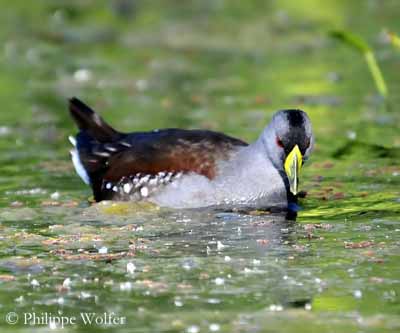
PROTECTION / THREATS / STATUS:
The Spot-flanked Gallinule is locally common or even widespread according to the range. This species is not currently threatened.
Fr: Gallinule à face noire
All : Maskenpfuhlhuhn
Esp : Gallineta Pintada
Ital : Gallinella fianchi macchiati
Nd : Zwartkopwaterhoen
Sd : Fläcksidig rörhöna
Port : Frango-d'água-carijó
Photographers :
Eduardo Andrés Jordan
MIS AVES – AVES DE ARGENTINA
Philippe and Aline Wolfer
OISEAUX D’ARGENTINE
Text by Nicole Bouglouan
Sources :
HANDBOOK OF THE BIRDS OF THE WORLD Volume 3 by Josep del Hoyo-Andrew Elliott-Jordi Sargatal - Lynx Edicions - ISBN : 8487334202
A GUIDE TO THE BIRDS OF COLOMBIA by Steven L. Hilty and William L. Brown - Princeton University Press – ISBN 069108372X
Avibase (Lepage Denis)
Oiseaux d'Argentine ( Philippe Wolfer)
Spot-flanked Gallinule
Gallinula melanops
Gruiforme Order – Rallidae Family
BIOMETRICS:
Length: 22-30 cm
Weight: 154 g
DESCRIPTION:
The Spot-flanked Gallinule inhabits the swamps and lakes of eastern South America. This bird is more similar to species of genus Porzana than Gallinula. It was formerly placed in the genus Porphyriops.

The adult has brown back, wings and uppertail. The flight feathers are dark grey to blackish.
Head, chin, throat and breast are slate grey. The belly is white as the undertail- coverts. The flanks are brown, conspicuously spotted white. Axillaries are barred.
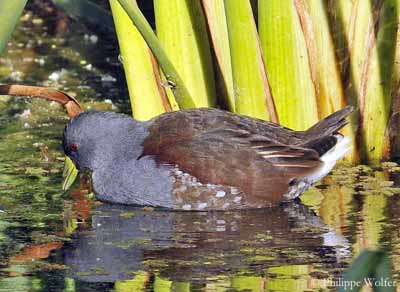
On the head, the foreface is black, extending in broad black band to the crown and the nape. The stout bill is greenish-yellow with small greenish, pointed frontal shield and blackish culmen. The eyes are red. Legs and feet are greenish-grey. The toes are lobed, that is unique in this genus. The lobes are small, difficult to see.
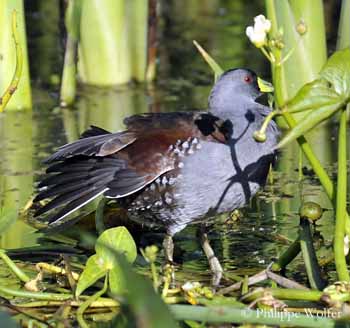
Both sexes are similar. In non-breeding plumage, the shield is duller.
The juvenile is olive-brown overall, with paler underparts and some faint spots on the flanks.
We can find three subspecies:
G.m. bogotensis from E Andes of Colombia.
G.m. melanops from E Bolivia and Paraguay, E and S Brazil to NE Argentina and Uruguay.
G.m. crassirostris from Chile and Argentina, except the extreme south.
They differ in size and colour of axillaries which are white in “bogotensis” and barred in the others. The race “crassirostris” is smaller but it has larger bill.
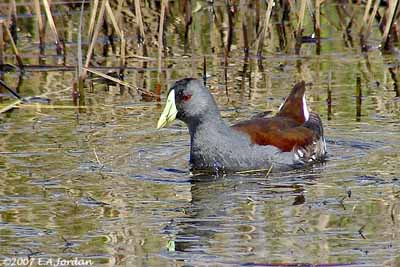
Race “crassirostris” from Chile
With larger bill
VOICE: SOUNDS BY XENO-CANTO
The Spot-flanked Gallinule utters loud, hollow cackling, similar to sudden burst of laugh. The beginning is loud and slow, and becomes brief and rapid while it dies away. This bird is mainly vocal in the evening.
HABITAT:
The Spot-flanked Gallinule frequents various wet areas such as ponds, lagoons, ditches, marshes and lake margins where it is locally common. These wet areas often provide dense floating vegetation.
But it also frequents the wet savannas and the reedbeds along rivers.
This species can be seen in temperate zones from 750 metres of elevation in Argentina, up to 2000-3000 metres in east Andes of Colombia.
RANGE:
See above in “subspecies”.
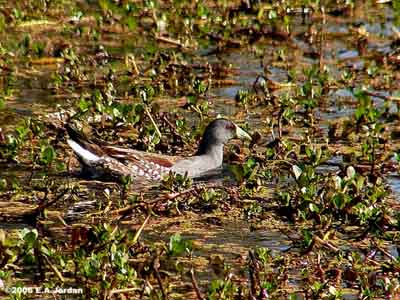
BEHAVIOUR:
The Spot-flanked Gallinule is often difficult to see in the reeds with its cryptic plumage, but it occurs regularly in open water areas.
It feeds while swimming, gleaning food from the aquatic vegetation or from water. It may dive under the surface to reach the food.
It rarely walks on the floating plants or even on the ground.
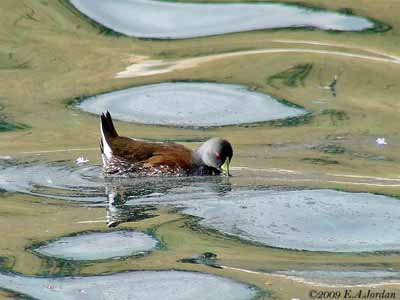
They can be seen in loose groups, in family parties and sometimes in larger flock when feeding. They swim and pick at the surface like the coots.
They often quarrel and chase each other, pattering across the water. They bob the head while swimming.
This species is probably resident in its range.
FLIGHT:
This aquatic bird flies rarely.
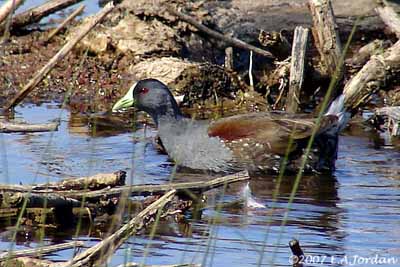
REPRODUCTION:
The breeding season varies according to the range.
The Spot-flanked Gallinule builds its nest close to the water, among the reeds or on damp ground, and usually slightly above the water level rather than on floating vegetation. The nest is made with dry rushes and may have a half dome.
The female lays 4-8 eggs. The brown downy chicks are precocial and leave the nest some hours after hatching. Both parents accompany them and they swim and feed together.
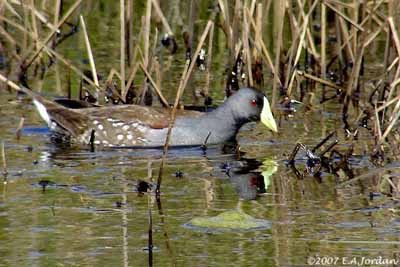
DIET:
The Spot-flanked Gallinule, as other members of genus Gallinula, feeds on plant matter from aquatic vegetation and takes seeds and buds. It also consumes invertebrates, insects, worms and molluscs.
It feeds by swimming, pecking at the surface or diving to reach food underwater. It may sometimes take small fish.
